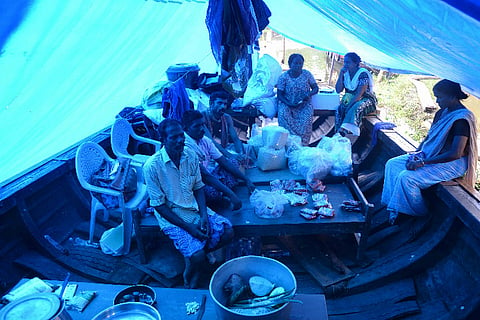

A few bags of rice, packets of chilli powder, bunches of bananas, vessels with cooked food and clothes hung out to dry... These are the first things one notices as they enter a big boat at the Mullassery ward in Kainakiri panchayat in Kuttanad. Seventeen families, who could no longer live in their houses that had been wrecked by floods, have made the boat a temporary relief camp.
Though the government has opened many relief camps across the Kuttanad region in Alappuzha district of Kerala, many have chosen to live on boats as the camps were crowded. For an outsider, this seems a more dangerous proposition as the boats would rock after a strong gust of wind. But for the 67 people of these families, the boat has become their temporary homes as they wait for the water to recede.
“The boat is hired for a daily rent of Rs 1000. The daily rent for the tarpaulin to roof the boat is Rs 200. The tarpaulin roof can blow away in the wind anytime and we are vigilant about that,” says Sanal Kumar, who lives in the boat.
Sanal and others had first tried to protect the bund in the nearby agricultural land from collapsing. They then built a side wall with sacks of sand to prevent rain water from entering their homes, but it was all in vain. By July 17, the torrential rain had ravaged both agricultural lands and houses.
As the flood waters rose, people in Mullassery had few options. Possibly the safest and driest option they could think of was boats, which are docked in the backwaters.
In Kuttanad, a region in one of the lowest altitudes in India, bunds are regularly built to protect agricultural lands and houses from being affected during incessant rains.
“On July 17, the bund fell. We all rushed out of the houses to prevent it; but our efforts were in vain. We all panicked, women began screaming, and none of us slept that night. There was chaos all around. We would hear screams from the neighbourbood and would try to rush there,” Vinod, who stays in the boat says.
On the boat, partitions have been made for men and woman. While women sleep on one side, men have been restricted to the other.
Though help for flood-affected people has been pouring in from the outside world, with billionaire businessmen, media houses giving financial assistance, NGOs and educational institutions pitching in with groceries and vegetables, the people on the boats get almost nothing. “It maybe because we are too isolated, so the help doesn’t reach us. We don’t know where the help goes. It’s tough for us to pay for the daily rent for the boat, the tarpaulin, we are all daily wage labourers,” says Mohanan.
Life in relief camps
For thousands in Kuttanad, life has become a nightmare. More than finding a place to sleep or sourcing food, what rattles them is the paucity of toilets. The ones that have been set up near the camps are overflowing.
In an auditorium at the panchayat at Kainakiri East, 47 people from 16 families have been housed. On July 16, they all had to run to the nearest shelter to save their lives.
“We came here with the clothes on our backs, nothing else. For the first two days we didn’t eat anything, and managed to survive on black tea and chips. It was terrible, the toilets were not usable anywhere. It was only after a few days that water receded in a few parts and we were able to use toilets in some houses,” says Thankamani at the relief camp at the auditorium.
It will take many more days for the flood waters to completely recede. The women groan in desperation when they talk about menstruation. “Sanitary napkins are being distributed; some have got it while others have not. Even if we get it, where would go and change?” asks Anju, a woman in her 20s. Anandam, Kusumam and Symala, all living with Anju in the camp, nod their heads in agreement.
“If we pay Rs 10 for the boat, we can go and use the toilet at the school there,” says Thankamani pointing her fingers at the St Mary’s school which is on the other side of the shore.
The ground floor of the auditorium is still flooded, forcing people to cook and sleep on the first floor. The clothes they now wear were donated by outsiders and not one person in the relief camp has been able to go back home.
Collecting rain water and buying water to cook
Across camps, there is a lack of water to cook or even to drink. For people of Kuttanad, who have lived their lives surrounded by water, the lack of water resources seems ironic.
Kuttanad, Kainakiri panchayath, the lowest lying area in Alappuzha district is the worst affected. “We are collecting rain water and using it for cooking. When the rain was strong the cans in which we were collecting water flew away. We now go to Alappuzha and buy water for drinking and cooking purposes,” says Lakshmikutty Amma who camps in the boat.
Manesh from Chennakari, says, “The government gives us food, but we need to find money to pay the boat fare to Alappuzha. We also need money to buy firewood. We are collecting money from the families who live here and buying water and firewood”.